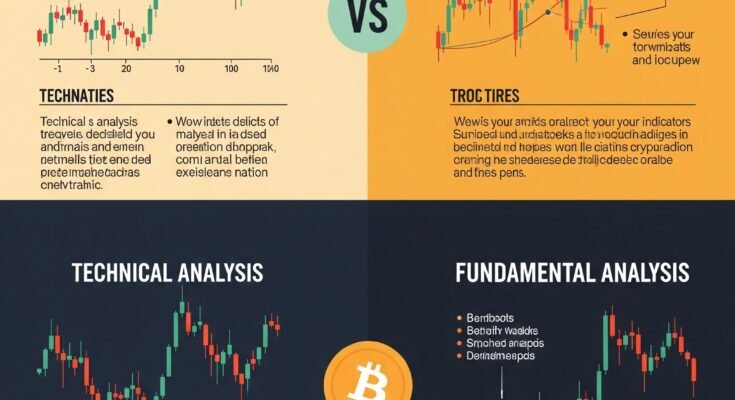crypto Treading market’s volatile and dynamic nature justifies the establishment and efficient use of strong analytical frameworks for identifying approaches in exploiting opportunities and mitigating risks. Two major techniques comprise the application of technical analysis and the assessment of fundamental aspects that present different perspectives for evaluating an asset. Technical analysis examines price patterns and market psychology, while fundamental analysis is more understanding of the actual values of a project. This article tends to discuss their differences, strengths, weaknesses, and how integration can maximize trading strategies.
1.Definition of the Approaches
Technical Analysis (TA)
It assumes that markets have trends and that “history repeats itself.” Because of this, TA does heavily employ charts, indicators, and statistical tools to identify patterns. Some of the tools are:
Patterns with candlesticks (for example, head and shoulders, triangles).
Two moving average lines (50-day, 200 day) to smooth out price trends.
TA is favored by short-term traders as a point of entry/exit, especially in a liquid, high-volatility market like crypto.
Some important metrics include:
Technology: Blockchain scalability, consensus mechanisms (such as Proof of Work vs. Proof of Stake).
Tokenomics: Supply dynamics, distribution models, and utility.
Team and adoption: developer know-how, partnerships, and community participation.
Regulatory environment: Legal hazards and institutional acceptability.
Fundamental Analysis
Fundamental Analysis is best suited to long-term investors wanting to identify undervalued projects with significant growth potential.
Differences between Technical and Fundamental Analysis
2.Check the key differences between the two approaches: Technical Analysis vs. Fundamental Analysis.
In what timeframes do they work?
Technical Analysis works mostly in the short term (with time horizon from a minute to a few weeks), while FA is preferably studied around the long-term horizon (with time frame intervals of months to even a few years).
What do they examine?
Technical Analysis mainly deals with data obtained from price charts, volume, and historical patterns, while for FA all kinds of data as contained within whitepapers, on-chain metrics, and team credibility are applied.
What is their market assumption?
Technical Analysis assumes a market in which prices reflect all available information, whereas FA works from the presumption that markets are inefficient; therefore, value≠price.
Who are their main users? Being the favorite hammer of day traders and swing traders, technically oriented analysis supports long-term holders and institutional investors.
3.Advantages and Disadvantages
Technical Analysis
Strengths:
- It supplies a signal which can be used in taking actions on timing when to trade.
- Profoundly effective in trending markets with well-defined patterns.
Limitations:
- External factors (e.g., regulatory news) are ignored.
- Many historical patterns cannot survive unprecedented events.
Fundamental Analysis
Strengths:
- Discovers long-term value from the hyped ones.
- Sense macro trends (e.g., Increasing growth of DeFi boosting Ethereum).
Limitations:
- Time-intensive, subjective.
4.Synergy: TA and FA together
Combining both methods denies both their potential arguments and improves decision-making in Crypto treading:
1.FA for Asset Selection: Use FA to weed out projects with a strong economic foundation (think Ethereum smart contract dominance).
2.TA for Timing: Use TA to pinpoint the best entry points (e.g., using RSI oversold signals during consolidations).
3.Sentiment Analysis: Gauge your market mood around social media or news to complement TA/FA signals.
Example: A trader might invest in Solana (FA: high-speed blockchain, growing DeFi ecosystem), but rely on TA to buy during a bullish MACD crossover.
5.Case Studies
In the timeframe 2020-2021, Bitcoin was driven by FA (fundamental analysis), especially the Tesla investment announcement, while the subsequent rise above $20,000 resistance was TA (technical analysis) territory.
Dogecoin, with its three-weeks amazing rise in 2021, was TA territory all the way down, largely driven by social media hype, whereas fundamentals were ignored (poor ones: no whitepaper, no roadmap).
6.Common Pitfalls to Avoid
- Overuse of One Method: Disregarding FA may lead to investing in viability schemes, while ignoring TA may lead to badly-timed entries.
- Emotional Trading: “FOMO” phenomena during bull runs are often contradictory to the analyses78.
- Misanalysis of Data: Selling as long as RSI>70 disregards some fundamentals, like a persistent strong uptrend.
7.Tools and Resources
- TA Resources: Treading view (Charting)
- FA Resources: Messari for on-chain data and CoinGecko for tokenomics.
- Hybrid Solutions: alt FINS merges TA signals and fundamental metrics like TVL and developer activity.
Conclusion(Crypto Treading)
Crypto Treading the TA and FA approaches should be understood as complementary, not competing. In an environment where TA leads to short-term trade execution, FA confirms the foundation of sustainable asset value. A mixed approach in an unpredictable world of crypto would carefully balance asset selection through FA and trade execution with TA toward profitable outcomes. As Su Zhu of Three Arrows Capital stated, to brush off all analysis in the “least efficient markets” of crypto would almost certainly lead to some very expensive mistakes1. The mastery of both ways allows traders to manage their risks, harness the opportunity, and thrive in a dynamic environment. crypto Treading
also read https://xampnews.com/cryptocurrency-a-good-investment-pros-cons-in-2025/
also read https://www.lcx.com/fundamental-analysis-vs-technical-analysis-in-crypto/



